Sunday, June 04 2017
As the weather heats up, rattlesnakes especially become more active. They, like humans, tend to explore when the weather gets warm. Also like humans (those who enjoy the great outdoors, that is), rattlesnakes tend to avoid developed areas, preferring undisturbed, natural habitats. That means the more you hike, hunt, camp, fish, bike and recreate in wilderness areas, the greater your chances of encountering a pit viper. And another thing they have in common with humans is they tend to be found in log piles and rocks and other natural "seats" where you might be likely to enjoy your lunch or bask in the sun. They also can be found in swampy areas. Snakes are able to regulate their body temperature by moving in and out of shade. A warmer body allows a snake to move faster when trying to catch prey (insects, slugs, frogs, birds, bird eggs, small mammals, and other reptiles). 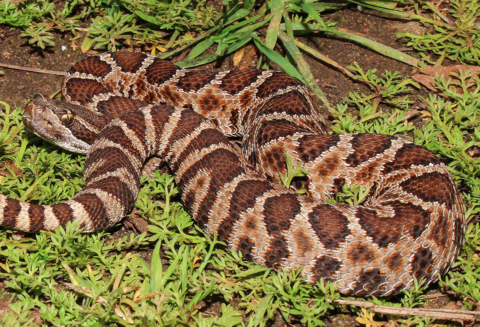
Rattlesnakes are native to North America, living in diverse habitats. There are 36 known species of rattlesnakes, with between 65 and 70 subspecies. The state with the most types of rattlesnakes are Texas and Arizona. Even baby rattlesnakes possess dangerous venom as soon as they hatch. Rattlesnakes all have the ability to rattle, hence their name, but they don't always make a rattling sound, so someone can be standing next to one and not even know it.
It is impossible to know what each and every variety of poisonous rattler looks like, but in general, they all have a triangular head, much wider than the neck, thick body with dull skin, and bands of color or splotches of color on backs and tail. Become familiar with the most common snakes found where you live or recreate. The three most common are:
Northern Pacific Rattlesnake: The color pattern is usually dark-brown, dark-gray, olive-brown, or sometimes black or pale yellowish ground color overlaid dorsally with a series of large, dark blotches with uneven white edges. These blotches are also wider than the spaces that separate them. Additionally, a lateral series of blotches, usually darker than the dorsal blotches, is clearly visible on all but the darkest specimens. The first rings of the tail are about the same color as the last body blotches, but these rings become progressively darker; the last two rings, at the base of the tail, are usually black. The belly is pale yellow, usually with brown spots. A large, dark-brown blotch on the snout has a pale border behind it. There is a dark brown postocular stripe with a white border that extends from the eye to around the angle of the jaw.
Western Diamond-Backed Rattlesnake: A large and heavy-bodied species, this rattlesnake's coloring varies from chalky gray to dull red, appearing dusty due to minute flecks and dots on the scales. As suggested by its common name, this species has diamond-shaped markings over most of its body, which are edged with black and white. These markings are replaced by conspicuous black and white bands towards the rear of the tail, just in front of the rattle, while the head has two characteristic pale stripes, one in front of the eye and the other behind, which run diagonally down the head towards the mouth.
Timber Rattlesnake: This is the only rattlesnake species in most of the populous northeastern United States; it is the third largest venomous snake in the United States.The physical color of a timber rattlesnake can vary widely depending on its area. Some are gray with a rich black pattern, some are tan with a sulfur yellow pattern, and some are a combination of both. They have V or W-shaped crossbar markings, which create a distinct pattern across its back. Generally they have a wide head and narrow necks. They have a distinctive rattler on its tail made up of a special scales. Their eyes are yellow, with elliptical pupils. These are large snakes, generally ranging from 36-60 inches (90-152 cm) in length and between 1.5 to 3 pounds.
It is estimated that 7,000 to 8,000 people are bitten by venomous snakes in the United States each year, resulting in many deaths. The most important factor in survival is the time elapsed between the bite and treatment. Most deaths occur between six and 48 hours after the bite. If antivenom treatment is given within two hours of the bite, the probability of recovery is greater than 99 percent. Still, any bite by a rattlesnake must be considered a life-threatening medical emergency!
When a bite occurs, the amount of venom injected is under voluntary control by the snake. The amount released depends on a variety of factors, including the condition of the snake (e.g. having long, healthy fangs and a full venom sack) and its temperament (an angry, hungry snake that has just been stepped on vs. a satiated snake that was merely surprised by walking near it). About 20% of bites result in no envenomation at all. Common symptoms include swelling, severe pain, tingling, weakness, anxiety, nausea and vomiting, hemorrhaging, perspiration, and eventually heart failure. Local pain is often intense, and will increase. Children generally experience more severe symptoms because they receive a larger amount of venom per unit of body mass.
What to do if bitten by a snake:
If bitten by a rattlesnake, stay calm and send someone to call 911. Always hike with a friend so you can help each other in case of emergency. The victim should remain calm by lying down with the affected limb lower than the heart. Do not waste precious time on tourniquets, "cutting and sucking," or snake bite kits. If you are by yourself, walk calmly to the nearest source of help: another person or a phone to Dial 911. Do Not Run. If you are not sure what kind of snake bit you, check the bite for two puncture marks (in rare cases one puncture mark) associated with intense, burning pain. This is typical of a rattle snake bite.
Although snakes of any kind are not "out to get you," bites can and do occur. Your best defense is don't take a chance! Wear snake gaiters or snake boots when in known snake country - whether that be the desert or woods - and greatly reduce your chances of being bitten!
Tuesday, May 02 2017
“Rattlesnake encounter in California State Park sends hiker to hospital”
“Elderly woman hospitalized after snake bite in Mobile”
“Rattlesnakes are coming out in Phoenix”
“Man flown to hospital after being bit by rattlesnake in Dallas”
“SC woman dies after rattlesnake bite at nature preserve”
“Rattlesnake bites boy who mistook it for a toy.”
 Headlines like these, while scary, serve a good purpose— to remind us to be alert and prepared while we’re in snake country. Worldwide, there are over 100,000 confirmed deaths from snakebites every year; the vast majority of those deaths do not occur in the United States. But when people here do get bitten, whether it’s by a rattler, cottonmouth, copperhead, coral snake, or other viper, it’s usually between the months of April and October. Headlines like these, while scary, serve a good purpose— to remind us to be alert and prepared while we’re in snake country. Worldwide, there are over 100,000 confirmed deaths from snakebites every year; the vast majority of those deaths do not occur in the United States. But when people here do get bitten, whether it’s by a rattler, cottonmouth, copperhead, coral snake, or other viper, it’s usually between the months of April and October.
Just about a quarter of all rattlesnake bites are “dry,” where no venom is injected. Other bites that do inject poisonous venom will definitely ruin your day, but not always kill you. The effects of being bitten are unpleasant to say the least. According to bite victims, your face starts tingling, your flesh feels like someone has sewn hot coals beneath your skin, your pulse flutters, and your limb puffs up like a water balloon. Not to mention the cost of being treated with anti-venom. Why even take that chance?
Overall, rattlesnakes are an important part of the ecosystem as they eat rodents and are eaten by other predators. They are generally shy creatures and will gladly retreat if given enough room, but their bites can be extremely dangerous, so knowing what to do to avoid them in the first place is key. The sound of rattling can instill cold fear in a hiker, but that's a good thing. You got the warning before accidentally stepping on or too close to a snake!
Despite the headlines, it’s possible to live and recreate safely around rattlers by taking precautions. The U.S. Fish and Wildlife Service recommends:
- Never go barefoot or wear sandals when walking through wild areas. Wear over-the-ankle hiking boots with snake gaiters, or wear snake proof boots. For full leg protection, consider snake chaps.
- When hiking, stick to well-used trails. Avoid tall grass, weeds and heavy underbrush where snakes may hide during the day.
- Do not step or put your hands where you cannot see and avoid wandering around in the dark. Step on logs and rocks, never over them, and be especially careful when climbing on rocks or gathering firewood.
- Check out stumps or logs before sitting down, and shake out sleeping bags before use.
- Never hike alone. Always have someone with you who can assist in an emergency.
- Teach children to respect snakes and to leave them alone. Children are naturally curious and will pick up snakes.
- Seek IMMEDIATE professional medical attention if bitten.
Monday, February 20 2017
Most posts on this blog are about protecting yourself from snake bite while outdoors— while hunting, hiking, clearing brush, or just walking your dog while in the desert or woods where snakes live. But what if you found a rattlesnake in your bathroom at home?!
Unfortunat ely, a family in Texas was recently taken by surprise when they discovered a live rattlesnake slithering in their toilet bowl! According to the family, the snake was pretty much alive and was doing its best to climb out of the toilet bowl. The family called in a snake removal company. Lucky they did that, not only for their own immediate safety, but because upon inspecting their house, the snake removal company found more than one stray snake. Unbeknownst to anyone, their cellar had become a rattlesnake den! ely, a family in Texas was recently taken by surprise when they discovered a live rattlesnake slithering in their toilet bowl! According to the family, the snake was pretty much alive and was doing its best to climb out of the toilet bowl. The family called in a snake removal company. Lucky they did that, not only for their own immediate safety, but because upon inspecting their house, the snake removal company found more than one stray snake. Unbeknownst to anyone, their cellar had become a rattlesnake den!
According to the company’s spokesperson, the snake removal team found more than 20 rattlesnakes in the family’s storm cellar. And, five of those snakes were infants. Rattlesnakes are extremely protective of their infants, but fortunately no injuries were reported by the family, and the large rattlesnake population was successfully relocated. As for the little creeper that exited through the family’s toilet, the experts believe that the snake somehow managed to enter a relief pipe and to make its way up. To ensure the family’s safety, the snake removal company sealed the relief pipe. After a clean sweep, no other rattlesnakes were found on the Texas family’s property.
Although the family claimed that they hadn’t seen a rattlesnake on their property for years, the company’s spokesperson declared that even though we can’t see them, snakes are still out there. Rattlesnakes and other poisonous vipers can be masters of disguise— relying on skin camouflage in order to elude bigger predators. That's how snakes can take up residence in your residence— if you don't hear a rattle, you don't necessarily know that they are there. Or they might be living in an area of your home or yard where you don't visit very often, such as a basement or outbuilding.
In addition to checking the rarely used areas of your home and property, your best defense against unwanted visitors is to make your property unattractive to snakes. Don't give them places to hide (abandoned junk piles and overgrown brush) and eliminate their food source such as mice and other small rodents. The neurotoxin carried by the snake’s venom can kill an adult in six hours or less. Even if not fatal, rattlesnake bite symptoms may include pain, tingling, swelling, numbness, nausea, weakness, and breathing issues— so don't take a chance! Whenever you are in snake country, protect yourself by wearing snake gaiters or snake boots and keep your eyes open to stay safe!
Tuesday, September 06 2016
Although kids heading back to school and the calendar tells us that summer is officially winding down, encounters with  snakes are not. Drought conditions, triple-digit temperatures, and other factors mean you still need to be very aware of the potential to see snakes, especially if you’re enjoying the outdoors in the late evening. snakes are not. Drought conditions, triple-digit temperatures, and other factors mean you still need to be very aware of the potential to see snakes, especially if you’re enjoying the outdoors in the late evening.
Snakes (pit vipers such as Copperheads, Cottonmouths, and Rattlesnakes are the most common) are not necessarily more active later in the day, you just might not see them as well now that the amount of sunlight each day is getting shorter, and the light is not as bright. When out in the evenings, carry a flashlight and watch where you put your hands and feet and watch where you sit down. And avoid walking close to bushes or crevices with large holes.
Reports of snake encounters have been particularly high in Texas and California this year. Texas is home to over 105 different species and subspecies of snakes; about 15 of those are potentially dangerous to humans. The Golden State is currently in the fifth year of a record drought. It seems that lack of rain results in an abundance of rattlesnakes. Rattlers are coming up from their outback burrows and wind up in backyards and parks. The California Fish and Wildlife Department. says in pre–drought years the populace averaged about 800 rattlesnake bites a year.
Medical experts advise that if you are among the 800 unlucky ones, forget everything you learned from old Western movies— no using a tourniquet, making an incision and trying to suck out the poison. A rattlesnake bite should be taken very seriously. Call 911 immediately! The faster you can get treatment, the better the outcome.The sooner you can get medical attention the sooner they can activate the system needed to get sufficient quantities of anti-venom to treat your bite. After that, the best but the hardest thing to do is try to remain calm. Avoid getting your heart rate up, which spreads the venom throughout your body faster.
The same advice goes for pets if they are bitten. "The sooner the animal gets treatment, the more than likely it's going to survive," said a veterinarian in El Paso, Texas. “There is an antivenin available, but it’s extremely expensive. The effectiveness depends of the size of the dog and the amount of venom injected by the snake. A dose of antivenin for pets can cost more than $1,000." The cost of Crofab— the human antivenin— in some cases can cost more than $10,000!
So no matter what the calendar might be telling us, keep in mind rattlesnakes are still in full force right now. They won’t go into hibernation in most areas for two or three more months. Whenever you’re out and about in snake country, or working in wooded areas or weeds, prevention is your best bet— wear snake gaiters or snake proof boots.
Sunday, July 17 2016
“The number of reported bites usually hovers in the double digits through May, June and July and then jumps to about 30 in August and September,” said an employee at the Arizona Poison and Drug Information Center. “It’s about a bite a day during those months before tapering off in October and November.”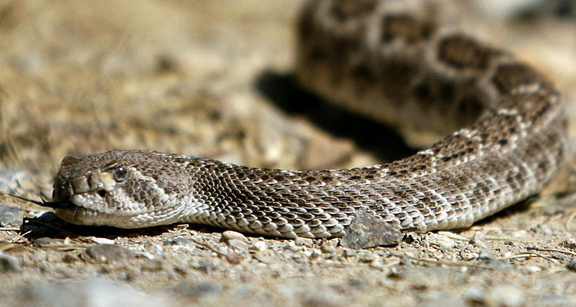
Yikes! A bite a day in just southern Arizona alone?! The Grand Canyon state is home to 13 species of rattlesnakes, with eight or nine species living in Southeastern Arizona, depending on how the region is defined, and on average, 150 to 160 rattlesnake bites are reported every year. Multiply those statistics by all the states where poisonous vipers live, and you know why you've got to be careful this summer!
Rattlesnakes typically come out of their winter dens in March or April, and return in November. They range far and wide — from deserts, canyons and forests to urban backyards. Some rattlers slither a mile or more from their dens to places where they spend the summer— many times in the same places where humans and dogs hike, camp, hunt and live. Some rattlesnake bites are so-called “dry bites” in which no venom is injected. Sometimes the dry-bite rate can be 20 percent. It all depends on the age of the snake, if it has recently eaten (and used its venom on the rodent it bit), and other factors.
“I’ve been a little bit paranoid just walking around the house now,” admits a home owner in Anaheim Hills, California who was hospitalized after she was bit in her own bathroom by a rattlesnake. Her neighbor’s Beagle was also bitten the week before by a baby rattlesnake. Both received anti-venom and are recovering. Fire officials say the appearance of rattlesnakes in Orange County is no rare occurrence. “The reason why we’re seeing more and more snake calls, and snake incidents, is because it’s so dry. It’s the fourth year of a serious drought, and it’s been so hot lately. These snakes are trying to find water.”
Rangers in Boulder County are warning hikers and cyclists to be on the lookout for snakes in the grass after a Wyoming resident who'd been visiting friends in Colorado was bitten on the shin by an adult snake that was about three feet long. The friends reportedly got off their bicycles and were crossing an open grassy area to go to a different trail when the woman was bitten. The victim was airlifted to a nearby hospital, treated with anti-venom, and was released.
"Contrary to many people's understanding, rattlesnakes do not deliberately harm people. They will only strike if threatened; otherwise, rattlesnakes will do everything possible to avoid a human encounter." Officials in Boulder caution people to watch where they step, particularly when in rocky or grassy open areas, and to be careful about what you wear. Especially this time of year the weather is beautiful and you want to wear shorts, but leaving one's legs bare and ankles exposed may not be wise for people who leave the traveled trails. Always keep your dogs on a short leash when hiking to minimize the opportunity for them to poke their nose where a prairie rattlesnake might be hiding.
Snake bite victims are generally not doing anything wrong. They are just in the wrong place at the wrong time— working in the yard or around a wood pile, or outside enjoying the summer— and nothing could have been done to prevent the bite. But if you are purposely going into known snake country to hike or hunt, the best prevention is to wear snake gaiters or snake proof boots.
If the worse happens, the best response to a bite is to go immediately to a medical facility for examination and treatment with anti-venom if needed. No cutting, no sucking, no tourniquets. Just get to a hospital. Other tips include not putting ice on the bite, and any limbs that are bit, whether it be on the arm or the leg, should be kept below the heart.
Friday, February 12 2016
It's only mid February, but high temperatures in many southwestern states, such as Arizona, are seeing an early spring warming trend, so now is a good time to remind everyone to beware of rattlesnakes! When snakes sense a litt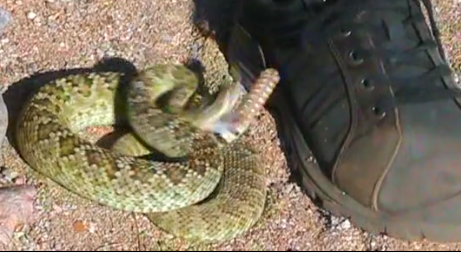 le bit of heat and humidity, they come out of hibernation, so now is the time they are becoming active again. Of course, no one sets out to encounter a snake, so the very best piece of advice is to be aware of your surroundings during rattlesnake season so you won't become a statistic. Two poison centers in Arizona alone treat an average 250-300 snake bite victims every year. The American Association of Poison Control Centers reported more than 750 rattlesnake bites in 2014 with 3 resulting in deaths. And that's just some of the stats. Minimize your chances of snake bite by following these tips: le bit of heat and humidity, they come out of hibernation, so now is the time they are becoming active again. Of course, no one sets out to encounter a snake, so the very best piece of advice is to be aware of your surroundings during rattlesnake season so you won't become a statistic. Two poison centers in Arizona alone treat an average 250-300 snake bite victims every year. The American Association of Poison Control Centers reported more than 750 rattlesnake bites in 2014 with 3 resulting in deaths. And that's just some of the stats. Minimize your chances of snake bite by following these tips:
- Wear closed-toe shoes. Sounds simple enough, but you'd be surprised at the number of sandal and flip-flop wearers on the trails. Above the ankle hiking boots and socks are even better - a lot of snake bites occur in the ankle area. Snake gaiters that cover from your ankle to your knee are your very best form of snake bite protection. And when hiking, don't just look straight down. Look ahead and to the side before you step. Although reptiles are most active during the months of April through October, during the hottest months they're most active at night. If it's dusk or dark outside, use a flashlight or headlamp to illuminate your path so you don't accidentally step on a snake.
- If you can't see it, don't stick your hand in it. This just doesn't apply to reaching under wood piles or into rock crevices, it also applies to golf. Don't stick your hand in a bush or a shrub for a wayward golf ball, as these areas are the perfect places for snakes to hang out. You don't want to startle one. Same theory applies if you're hiking or rock climbing or gardening. And remember, rattlesnakes can swim so look twice if you see a floating "stick" in the water!
- Don't underestimate a baby rattlesnake. There is no such thing as a cute rattlesnake. Baby rattlesnake venom is just as deadly as older snakes, and due to their smaller size, they can be harder to see and thus avoid. Younger rattlesnakes are born without a traditional rattle, so you can't always rely on the noise as a warning. Since rodents are a primary source of food for rattlesnakes, be sure to get rid of any rodents in your yard. Be careful with bird feeders too because those can attract rodents and snakes will be drawn to the smell of birds and rodents. Don't give those baby rattlers fuel for growing up!
- Practice proper trail etiquette. Experienced hikers know that there is an internationally accepted "triangle" of trail etiquette: Mountain bikers yield to runners, hikers and horses. Runners and hikers yield to horses. Horses are not required to yield to any group. But everyone and everything yields to snakes! Give them a wide berth if you spot one on the trail or even sunning itself on a rock. Don't try to kill or immobilize a snake. Save your pepper spray, too, because that won't work— just back away slowly and avoid a confrontation. If you are close enough to make a direct hit with the pepper spray, you’re close enough to get bit. Not a good place to be. And why aggravate a snake by spraying it anyway? Snakes don’t have eyelids, but they do have a transparent shield that protects their eyes, so the spray won’t really blind them. And while mammals are sensitive to the stuff in pepper spray, reptiles aren’t.
- Do not handle snakes even if you think they are dead. Believe it or not, some rattlesnakes can still strike and inject you with venom when they're dead. This is true even if the snake's head is cut off. Don't take a selfie or reach your hand out to touch it!
Snakes are always around, and with nicer weather, snakes and humans are becoming more active in the same environments so the potential for encounters increase. Unfortunately this can mean getting bitten while gardening, pulling weeds around your yard, walking to the mailbox, or hiking with your dog. There's a perception that most people are bit when they've been playing with or bothering a snake, but mostly it's acci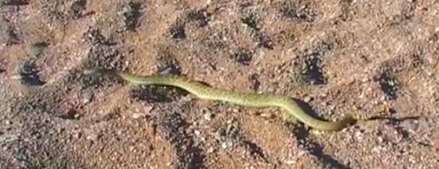 dental— being in the wrong place at the wrong time with a snake. dental— being in the wrong place at the wrong time with a snake.
Because the number of snake-bite reports increase as temperatures creep up, now is a good time of year to be reminded that being aware of your surroundings is the best thing you can do to stay safe in snake country. And if you frequently have a canine companion or two with you, consider a dog vest that protects them not only from snake bite, but from painful cactus needles, briars, and more.
Although you should be aware of the potential for a rattlesnake bite, don't be so worried you don't venture outdoors. Most people don't die as a result of a snake bite, as long as they get medical attention fast. The best thing you can do if bitten is to immobilize the wound and get to the hospital immediately. Most patients are out of the hospital in two days and then spend the next few weeks getting follow-up treatments. A typical person takes about a month to get "back to normal." Being bitten can cause severe injury and long-term complications, but being alert to the dangers of snakes and using snake bite protection can help you avoid them in the first place, and stay safe while in their territory.
Thursday, October 29 2015
Snakes are seen just about everywhere from spring through October, and then they are presumed to hibernate. But that's not always true. Snakes are more reactive to consistently cold weather, rather than a change of seasons. Rattlesnakes are even known to move around during extended warm periods during winter months, especially if they hole up in a stump or other location that can be warmed easily by sunshine. 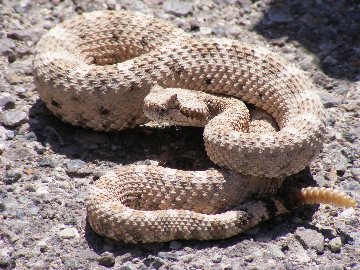
Snakes do not actually hibernate, rather they become less active during cold weather. It is called "brumation." Brumation is an extreme slowing down of their metabolism. Snakes are awake, but just very lethargic so you don't see them moving around. In the fall, snakes move back to the previous year’s den. If a sudden cold snap catches them before they get there, they may die if not fortunate enough to find a suitable secondary den. They usually do not stay long at the den entrance, but hurry in for the long winter sleep. A number of species may share the same den. For example, black rat snakes, timber rattlesnakes and copperheads commonly den together. Sometimes there will be as many as 100 snakes in one cave. A group site is called a hibernaculum.
Cold-blooded animals like snakes, fish, frogs, and turtles need to spend the winter inactive, or dormant, because they have no way to keep warm. Snakes will crawl into any area free from frost such as caves, hollow logs, holes under trees and stumps, under wood piles, in other animal's burrows, and occasionally in a person's basement.
Snakes will increase their intake of food before brumation occurs, if they can. Not all snakes will survive brumation. A skinny snake will not survive. If the snake feeds heavily before they hibernate, and have digested their meal before the cooling starts, they will be OK. If food is in their stomach or intestines when they cool, it will rot and kill them. Vipers can also brumate during normal conditions, due to a loss of food, but normally when they become dormant it corresponds with extreme temperature changes.
On warmer days in late fall, early spring, or even during winters, brumating snakes sometimes come out of their dens to bask in the sunshine. Nice sunny days that follow a long cold snap are often when people are surprised by rattlers. Just like humans, snakes head out to enjoy the sun and unsuspecting hikers can startle them and cause them to strike. Generally, rattlesnakes emerge from hibernation in March or April, or when the average daytime temperatures reach and remain about 60 degrees Fahrenheit and higher.
During a typical year, an estimated 45,000 people are bitten by snakes in the United States. That number is reason enough to always wear snake boots or snake gaiters when in the desert or the woods. If you do, you won't have to worry so much about the temperature or the season — use common sense to keep yourself safe. Hunters should be especially vigilant and wear snake protection!
Monday, September 14 2015
Stay safe in those snake infested areas at work and play. Browse snake gaiters here.
Monday, August 17 2015
There is some concern that the drought in California has led to an increase in rattlesnake bites across the state. Along with many 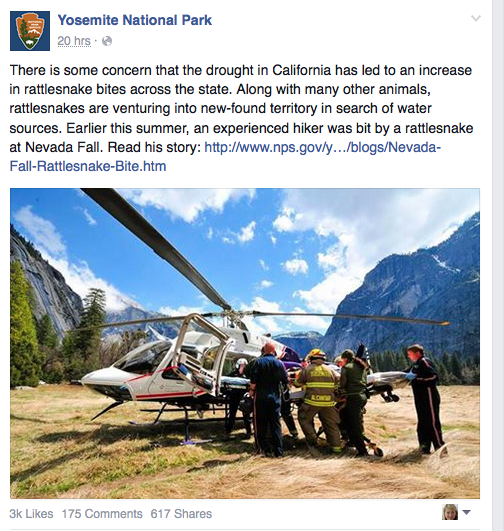 other animals, rattlesnakes are venturing into new-found territory in search of water sources. Earlier this summer, an experienced hiker was bit by a rattlesnake at Nevada Fall. The story was posted today on Facebook with a link to the Yosemite National Park website. Below is an excerpt: other animals, rattlesnakes are venturing into new-found territory in search of water sources. Earlier this summer, an experienced hiker was bit by a rattlesnake at Nevada Fall. The story was posted today on Facebook with a link to the Yosemite National Park website. Below is an excerpt:
On June 29, 2015, sometime around 4 pm, a 49-year-old day hiker at the top of Nevada Fall experienced what many people would consider their worst nightmare: being bitten, and envenomated, by a rattlesnake. He was an experienced hiker and had come across rattlesnakes in the wild before.
The top of Nevada Fall was the objective for the subject and his family. Upon reaching the footbridge at the top of the fall, they decided to do what many hikers feel the need to do after walking in the afternoon heat: take off their shoes and cool their feet at a safe spot in the river. As the subject made his way back onto the granite shoreline, he stepped down into a shallow recess between several rocks and was immediately bitten on the right foot. Moments later, another member of the subject’s family dialed 911 and reported the incident, at which time Yosemite Search and Rescue began to mobilize their response.
A rescue team began hiking to the patient's location as park helicopter 551 mobilized. Approximately one hour after being bitten, 551 airlifted the subject from the top of Nevada Fall and flown to the valley floor, where medical care was waiting. The clinic staff administered antivenom medication to the subject, stabilized him, and readied him for transport to a regional hospital via a medical helicopter.
Many people see rattlesnakes while hiking in Yosemite. Snake bites are rare here, but it is important to know that they do occur and that the resulting injuries can be serious: this subject spent several days in the hospital recovering from his bite. It is understandable that the patient was barefoot while wading, but for the rest of the hike, a pair of snake boots or other sturdy shoes can protect against many snakebites. Snake gaiters offer snake bite protection from approximately your knee down to your ankle and should be worn with sturdy boots. An important lesson to learn from this incident is to always be aware of where you place your hands and feet—in addition to snakes, crevices can hide scorpions, spiders, and yellow jacket nests. This hiker didn't do anything wrong. In this case it just happened to be that a viper proved to be the most dangerous part of the trip— not the obvious hazards of the quickly flowing river, the granite cliffs, or the midday heat.
If you are bitten, keep in mind that the most effective treatment for snakebite is to seek medical care at a hospital or emergency room as quickly as possible. Gone are the days when snakebite first aid involved cutting into the bite and sucking the venom out of the body. Don't try it! It doesn't work!
Finally, treat all wildlife with respect and give them the space they need to stay wild. Never approach wildlife to feed, pet, or photograph them. No matter how docile the animal or reptile may appear, it is wild and could spook easily.
Monday, August 03 2015
No one knows for sure how many people are actually treated for venomous snakebite annually, but according to a Parks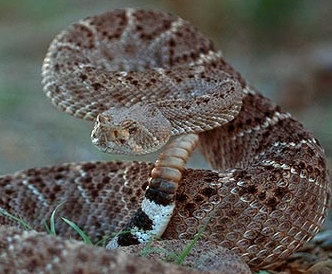 and Wildlife Department herpetologist, each state usually reports of one or two deaths per year. For those bitten who survive, treatment for rattlesnake bites reportedly runs anywhere from about $20,000 at the minimum up into the six-figure range. Anti-venom and treatment is very expensive! Young children out exploring and intoxicated young men make up a good chunk of the bite victims. Hikers and hunters also get bitten, as do those who work in and around snake habitat, especially when moving logs and rock piles. and Wildlife Department herpetologist, each state usually reports of one or two deaths per year. For those bitten who survive, treatment for rattlesnake bites reportedly runs anywhere from about $20,000 at the minimum up into the six-figure range. Anti-venom and treatment is very expensive! Young children out exploring and intoxicated young men make up a good chunk of the bite victims. Hikers and hunters also get bitten, as do those who work in and around snake habitat, especially when moving logs and rock piles.
To keep you and your family safe, it’s important to be aware of your surroundings and to know which venomous snakes you might encounter where you live, work, and play. Texas has the most snake bites annually in the country, usually between 500 and 1,000. One-third to a half of those bites are venomous. Experts in the Lone Star State say you only need to worry about four species: western diamondback rattlesnake, copperhead, coral snake, and cottonmouth (also called water moccasin). Size does not matter because they are venomous at birth.
Coral snakes spend most of their time under leaves and logs and few people ever see them. They really aren’t a threat unless they are handled. Cottonmouths have black and white chins, float on top of the water and are not all that common. The copperhead is the only snake in Texas that is a two-color banded snake. The majority of venomous snakes sighted in residential yards are the diamondback. This rattlesnake sheds within 10 days of being born and then scatters. Babies end up in some strange places, like back steps and garages, looking for mice and lizards to eat, so you’re most likely to see this snake around homes and sheds. Adult diamondbacks want to stay away from activities and people. The most common snakes people encounter that are not poisonous are rat snakes—the only large snake that climbs.
Texas, of course, isn’t the only state with vipers. Oklahoma is home to five species of rattlesnakes. Three venomous species call Pennsylvania home— the northern copperhead, timber rattlesnake, and eastern massasauga rattlesnake. In California, where more than 800 humans are bitten each year, there are at least six types of rattlesnakes to be concerned about. Arizona has 13 species of rattlesnakes, and Nevada has six. Alaska is the only state that has never reported a venomous snake. For a list by state, visit http://www.venombyte.com/venom/snakes/venomous_snakes_by_state.asp
The best suggestions for avoiding snake bite is common sense and prevention. Don’t walk through tall grass. Places like flooded pastures create great breeding sites for frogs and feeding sites for frog hunters like snakes. Walk around rock piles and logs instead of stepping over them. If you see a snake, leave it alone. Remember that snakes are just as active in the fall as they are in the spring, so hunters should be extra cautious. No matter which state you live in, it makes sense to think about snake bite protection in advance of being outdoors — simply wear snake gaiters or snake boots. If you are bitten, below are a few do's and dont's suggested by medical professionals:
What to Do if You Are Bitten by a Snake
- Call 911 immediately.
- Stay as calm as possible.
- Get away from the snake but stay as immobile as possible until help has arrived.
- Remove clothing or accessories that may restrict your blood flow and cause swelling.
What Not to Do if You Are Bitten by a Snake
- Don’t try to capture the snake – this is unnecessary and can lead to a more dangerous situation.
- Don’t create an incision or suction the wound.
- Don’t administer any drugs to the victim.
- Don’t apply a tourniquet (restrictive device used to constrict the flow of blood to a body part).
- Don’t apply ice to the snakebite.
- Don’t wait to see if symptoms occur – seek professional medical help immediately!
|